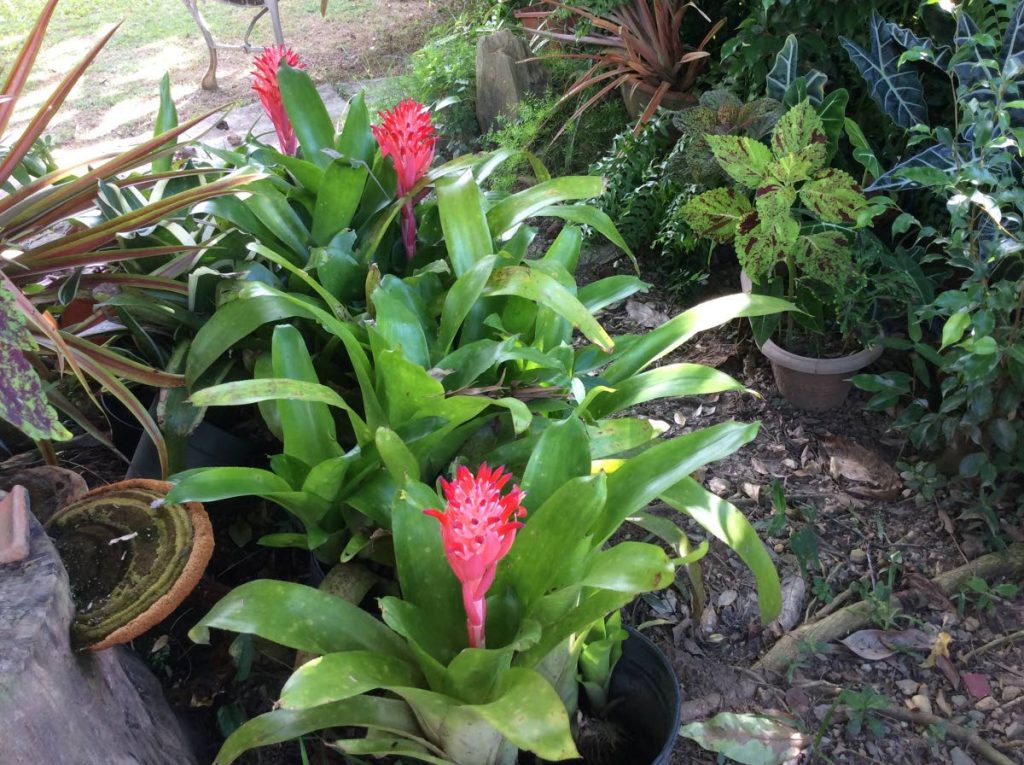Gardening in the rainy season

Hyacinth Cross
The United Nations General Assembly has named 2020 International Year of Plant Health. We admire healthy plants and the best time to see some really healthy robust plants is during the rainy season. Plants thrive much better in the rainy season and they seem ungrateful after all the wetting we did in the dry season; one shower and everything comes alive and a freshness and newness seem to come from the magical rain.
Rainy season is also a time of so many surprises. Plants you were sure you had lost somehow suddenly reappear, sometimes after not being around for two or more years. Of course the job of weeding becomes a big challenge as so many weeds are happy to resurface, especially the “shining bush.” They emerge fat and healthy in every pot. Fortunately they are easily removed, as they do not resist uprooting.
So how do I garden in the rainy season? Systematically and area by area. Today it is bromeliads. Remove all the dry leaves sprinkle dried tulsi seeds in the cups where water settles to prevent the mosquitoes from breeding in them. If there are pups to be removed and planted that is done in a soilless medium that drains well. There are many recipes for suitable bromeliad mixes on the internet. The next job is re-arranging and re-designing the area where the bromeliads are located, maybe adding a boulder here or a new plant there for a change.
This is the time to shelter your cacti and succulents. It is amazing how quickly succulents will rot and die with too much water.
Then it is sansevieria day. Plants are separated where necessary and pots are topped up with soil. These plants tend to be susceptible to scale infestation, so a drenching of the soil with a systemic insecticide (follow the manufacturer’s instructions) followed by granular fertiliser. Plants in pots can be placed under the windows as they tend to do better if the soil is allowed to dry out before watering again.
Next are the evergreens and ferns. Evergreens that have lost their lower leaves and are stringy are cut just above an eye so that two new shoots can spring out, the cane that is cut off can be planted in the same pot or a new pot. Fertiliser is added and the pots topped up with soil.
Dry fronds from the ferns are cut out, plants cleaned and fertilised and placed where they can enjoy the water.
The focus is on one type of plant for a day or two, care for them, re-arrange or re-locate if necessary, chatting with them as you go along, thanking them for the joy and compliments they bring.
Rainy season gardening requires more dedication, planning and energy than that in the dry season. It takes up more time and observation. Some plants seem to have growth spurts and become very bushy. Don’t be over-zealous with the pruning shears and when trimming always cut at a moderate angle, as opposed to straight across, followed by the application of a sealing compound on cuts larger than one inch. Attention should be paid to the soil mixture to ensure proper drainage, to mitigate the damage caused by pests such as mites, scale insects and aphids as well as bacterial and fungal infestations caused by the damp conditions.
Spare a week for weeding doing one area at a time and empty your pots and refill with fresh soil if the need arises. Keep trimming plants and make new ones in preparation for Christmas gifts, exchanges and or sales. It is definitely a truly rewarding time for gardening as everything looks so fresh and green and full of surprises.
Happy gardening.
For further information contact the Eastern Horticultural Club at 357-5033, or 720-2698 or easternhorticultural@hotmail.com The club usually meets on the first Saturday of every month, however, due to the current covid19 restrictions meetings have been suspended until further notice.


Comments
"Gardening in the rainy season"